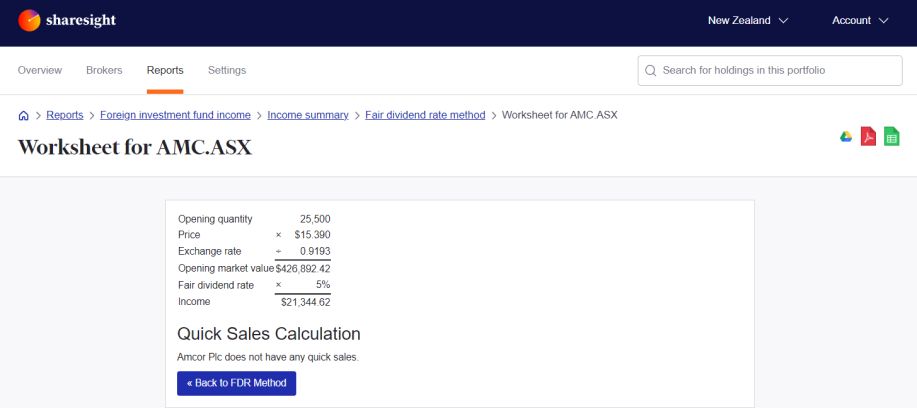How can we help?
FIF Fair Dividend Rate (FDR) Report
The FIF Fair Dividend Rate Report is part of the FIF Report available within Sharesight.
Note: This report is only available in New Zealand tax residency portfolios on Expert and Sharesight Pro plans.
Under the Fair Dividend Rate (FDR) method, tax is paid on 5% of the share portfolio's opening market value each year. Generally, only shares held at the start of an income year are taken into account and therefore purchases and sales of shares during a year are excluded. However, shares that are purchased and sold in the same income year are taxed on the lower of 5% of their cost or the actual gains made on these "quick sales".

FIF Fair Dividend Rate Report
It lists the opening value all FIF shares held throughout the period and any quick sales adjustments if applicable. A quick sale occurs if shares in a company are bought and sold within the same income year. Quick sale adjustments can be calculated using two possible methods (as detailed below), but only one method can be used in any given income year. Sharesight will select the method which gives you the lowest total amount across all holdings.
At the end of each line item in the FDR table there is a link to a detailed worksheet that provides an analysis of the inputs and calculations.

Peak Holding Gain Method
The peak holding gain is calculated using the formula: 5% x quick sales x average cost
The "quick sales" amount in the peak holding adjustment formula is the lower of:
- the difference between the greatest number of shares held in the foreign company during the income year and the number of shares held in the foreign company at the start of the income year; and
- the difference between the greatest number of shares held in the foreign company during the income year and the number of shares held in the foreign company at the end of the income year.
The "average cost" component in the peak holding adjustment formula is the amount of expenditure that the shareholder incurs during the income year in acquiring or increasing their shareholding in a foreign company, divided by the total number of shares acquired in the foreign company during the income year. The average cost method is used when different parcels of shares in the same company are purchased during the year at different prices.
Quick Sale Gains Method
The quick sale gain is calculated by taking the total amount derived from quick sales (including any dividends) and subtracting the total expenditure incurred in acquiring those shares. A last-in-first-out (LIFO) method applies to determine the gains made on quick sales. The quick sale gain cannot be less than zero, i.e. if the calculation yields a negative amount it cannot be netted off the total balance if this is positive.
Last updated 17th December 2025